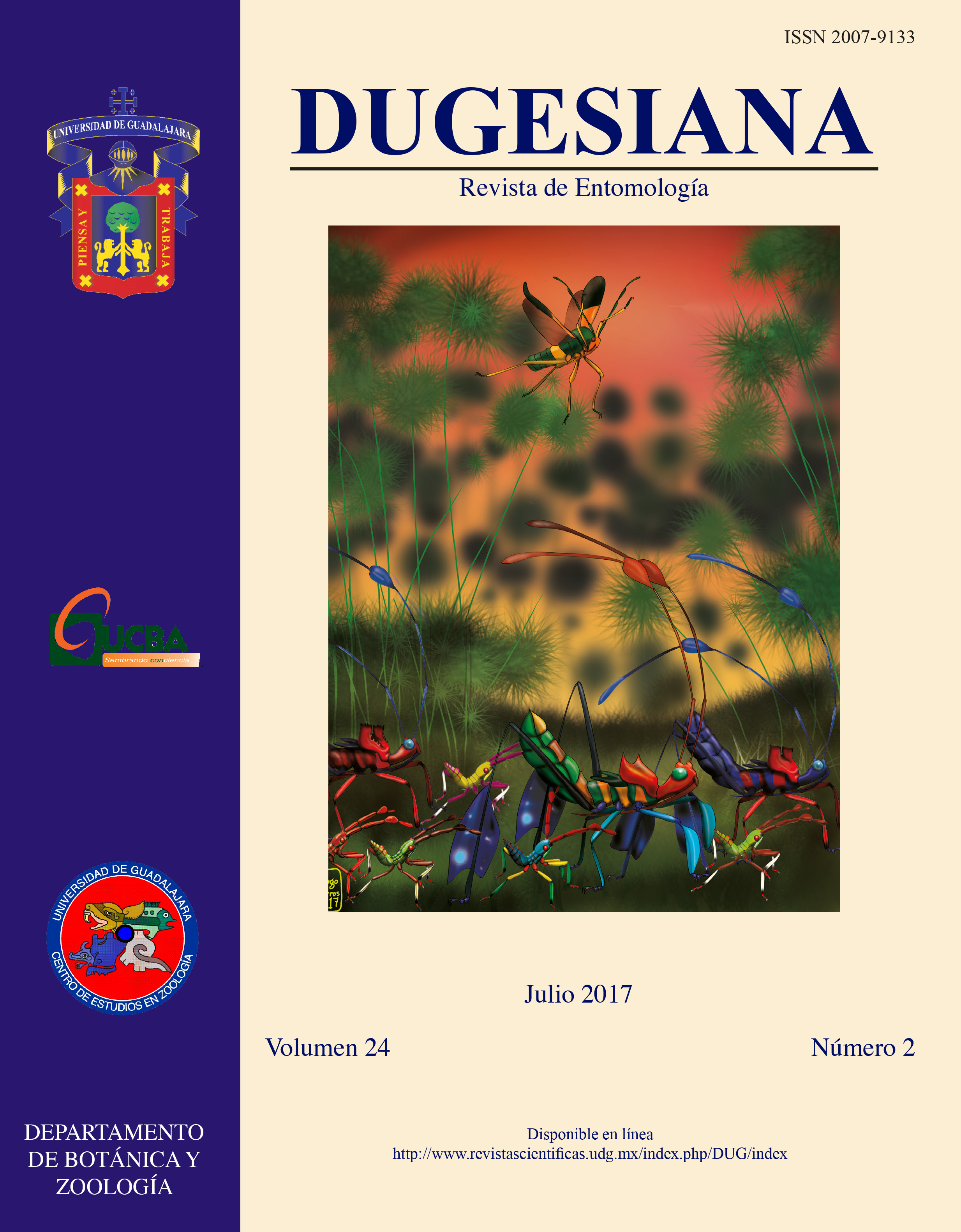Cylapocoris braylovskyi and C. vittatus two new species of Cylapocoris Carvalho, 1954 (Hemiptera: Heteroptera: Miridae) from Costa Rica, Ecuador and Panama
DOI:
https://doi.org/10.32870/dugesiana.v24i2.6823Keywords:
Heteroptera, Miridae, Cylapocoris, diagnosis, new species, NeotropicsAbstract
Two new species of the genus Cylapocoris Carvalho – C. braylovskyi and C. vittatus are described from Ecuador and Panama. For C. brailovskyi illustrations of the male genitalia and for C. vittatus scanning electron micrographs are given..References
Carvalho, J.C.M. 1954. Neotropical Miridae. LXXIV: Two
New Genera of Cylapinae from Brazil. Proceedings of
the Iowa Academy of Sciences, 61: 504–510.
Carvalho, J.C.M. 1976.AnalectaMiridologica: Concerning
changes of taxonomic positions of some genera and
species (Hemiptera). Revista Brasileira de Biologia, 36: 49–59.
Carvalho, J.C.M. 1982. Mirideos neotropicais CCXXXIX:
descrições de algumas espécies de Cylapinae do
Amazonas (Hemiptera). Acta Amazonica, 12: 811–815.
Carvalho, J.C.M. 1989. Mirideos neotropicais, CCC:
generos e espécies novos da America Central e America
do Sul (Hemiptera). Revista Brasileira de Biologia, 49:261–269.
Carvalho, J.C.M. & Gomes, I.P. 1971. Mirideos
neotropicais, CXXXVI: Genero Cylapocoris Carvalho
com a descriçao de uma nova especie (Hemipera).
Revista Brasileira de Biologia, 31: 485–488.
Cassis, G 2008. The Lattinova complex of austromirine
plant bugs (Hemiptera: Heteroptera: Miridae:
Orthotylinae). Proceedings of the Entomological
Society of Washington, 110(4): 845–939. https://doi.
org/10.4289/0013-8797-110.4.845
Kerzhner, I.M., Konstantinov, F.V. 1999.Structure of the
aedeagus in Miridae (Heteroptera) and its bearing to
suprageneric classification. Acta Societatis Zoologicae
Bohemicae, 63: 117–137.
Konstantinov, F.V. 2003. Male genitalia in Miridae
(Heteroptera) and their significance for suprageneric
classification of the family. Part 1: general review,
Isometopinae and Psallopinae. Belgian Journal of
Entomology, 5: 3–36.
Wolski, A. 2013. Revision of the plant bug genus
Cylapocoris (Hemiptera: Heteroptera: Miridae:
Cylapinae), with descriptions of seven new species
from Costa Rica, Brazil, Ecuador, and Venezuela.
Zootaxa, 3721 (6): 501-528.
Additional Files
Published
Issue
Section
License
1. Proposed policy for open access journals
Those authors who have publications with this journal, accept the following terms:
- The authors will retain their copyright and will guarantee to the journal the right of first publication of their work, which will be simultaneously subject to the Creative Commons Recognition License, which allows third parties to share the work whenever their author is indicated and His first publication is this journal.
- Authors may adopt other non-exclusive license agreements to distribute the version of the published work (eg to be deposited in an institutional telematic file or published in a monographic volume) provided the initial publication is indicated in this journal .
Authors are encouraged and encouraged to disseminate their work through the Internet (eg in institutional telematic files or on their web page) before and during the sending process, which can produce interesting exchanges and increase appointments Of the published work. (See The effect of open access).
2. Proposed policy for journals that offer open deferred access
Those authors who have publications with this journal, accept the following terms:
- The authors will retain their copyrights and will guarantee to the journal the right of first publication of their work [SPECIFY PERIOD OF TIME], which will be simultaneously subject to the Creative Commons Recognition License that allows third parties to share the work always That its author and his first publication be indicated this journal.
- Authors may adopt other non-exclusive license agreements to distribute the version of the published work (eg to be deposited in an institutional telematic file or published in a monographic volume) provided the initial publication is indicated in this journal .
- Authors are encouraged and encouraged to disseminate their work through the Internet (eg in institutional telematic files or on their web page) before and during the sending process, which can produce interesting exchanges and increase appointments Of the published work. (See The effect of open access).




